
Centipede is a 1981 fixed shooter video game developed and published by Atari for arcades. Designed by Dona Bailey and Ed Logg, it was one of the most commercially successful games from the golden age of arcade video games and one of the first with a significant female player base. The primary objective is to shoot all the segments of a centipede that winds down the playing field. An arcade sequel, Millipede, followed in 1982.
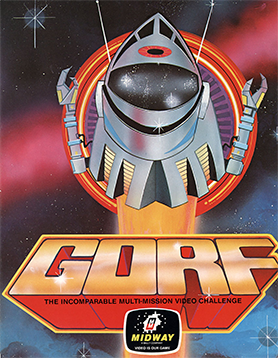
Gorf is an arcade video game released in 1981 by Dave Nutting Associates. It is a fixed shooter with five distinct levels, the first of which is based on Space Invaders and another on Galaxian. The game makes use of synthesized speech for the Gorfian robot which taunts the player, powered by a speech chip. Gorf allows the player to buy two additional lives per quarter before starting the game, for a maximum of seven lives.

Choplifter is a military-themed scrolling shooter developed by Dan Gorlin for the Apple II and published by Broderbund in 1982. It was ported to the Atari 8-bit computers the same year, and also to the VIC-20, Commodore 64, Atari 5200, ColecoVision, MSX, and Thomson computers.

B.C.'s Quest for Tires is a horizontally scrolling video game designed by Rick Banks and Michael Bate and published by Sierra On-Line in 1983. Versions were released for the Commodore 64, IBM PC, Atari 8-bit computers, ColecoVision, ZX Spectrum, MSX, and Apple II. Based on the comic strip B.C. by Johnny Hart, BC's Quest for Tires is similar to Irem's Moon Patrol from the previous year. A wheel-riding caveman is always moving forward through horizontally scrolling levels, and the player jumps or ducks as obstacles approach. The game's title is a play on the contemporaneous film Quest for Fire.
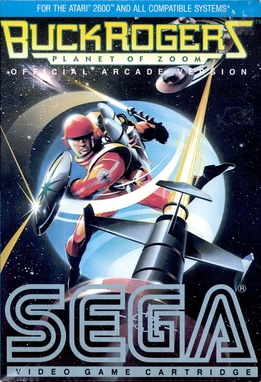
Buck Rogers: Planet of Zoom, known as Zoom 909 in Japan, is a pseudo-3D rail shooter released as an arcade video game by Sega in 1982. The player controls a spaceship in a third-person perspective, adapting the three-dimensional perspective of Sega's earlier racing game Turbo (1981) for the space shoot 'em up genre. It uses the Buck Rogers license, referencing the space battles, though Buck himself is never seen.

The Eidolon is one of two games that were part of Lucasfilm Games' second wave in December 1985. The other was Koronis Rift. Both took advantage of the fractal technology developed for Rescue on Fractalus!, further enhancing it. In The Eidolon, Rescue's fractal mountains were turned upside down and became the inside of a cave.
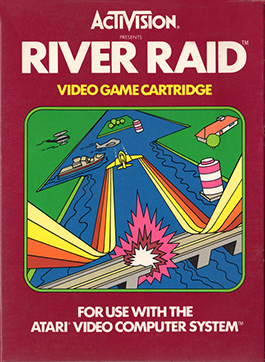
River Raid is a 1982 shoot 'em up video game developed and published by Activision for the Atari 2600. Designed by Carol Shaw, the player controls a fighter jet over the River of No Return in a raid behind enemy lines. The goal is to navigate the flight by destroying enemy tankers, helicopters, fuel depots and bridges without running out of fuel or crashing.

Beamrider is a fixed shooter written for the Intellivision by David Rolfe and published by Activision in 1983. The game was ported to the Atari 2600, Atari 5200, Atari 8-bit computers, ColecoVision, Commodore 64, ZX Spectrum, and MSX.
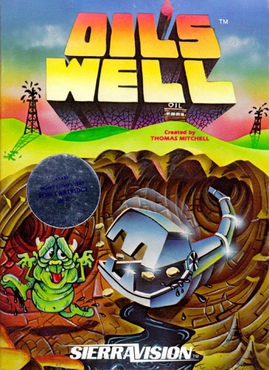
Oil's Well is a video game published by Sierra On-Line in 1983. The game was written for the Atari 8-bit computers by Thomas J. Mitchell. Oil's Well is similar to the 1982 arcade game Anteater, re-themed to be about drilling for oil instead of a hungry insectivore. Ports were released in 1983 for the Apple II and Commodore 64, in 1984 for ColecoVision and the IBM PC, then in 1985 for MSX and the Sharp X1. A version with improved visuals and without Mitchell's involvement was released for MS-DOS in 1990.

Frogger II: ThreeeDeep! is a video game released in 1984 by Parker Brothers for the Apple II, Atari 8-bit computers, Atari 2600, Atari 5200, ColecoVision, Commodore 64, and IBM PC compatibles. It is a sequel to the 1981 Konami Frogger arcade video game and has similar gameplay.

Gateway to Apshai is an action-adventure game for the Commodore 64, ColecoVision and Atari 8-bit computers. It was developed by The Connelley Group and published by Epyx in 1983 as a prequel to Temple of Apshai. It is a more action-oriented version of Temple of Apshai, with smoother and faster graphics, streamlined controls, fewer role-playing video game elements, and fewer room descriptions.

Worms? is a puzzle video game written by David Maynard for Atari 8-bit computers and ported to the Commodore 64. It was released in 1983 as one of the first publications from Electronic Arts. Worms? is an interactive version of Paterson's Worms.

Tutankham is a 1982 arcade video game developed and released by Konami and released by Stern in North America. Named after the Egyptian pharaoh Tutankhamun, the game combines a maze shoot 'em up with light puzzle-solving elements. It debuted at the European ATE and IMA amusement shows in January 1982 before releasing worldwide in Summer 1982. The game was a critical and commercial success and was ported to home systems by Parker Brothers.

Serpentine is a maze video game written by David Snider for the Apple II and published by Broderbund in 1982. Serpentine's gameplay and visuals are similar to the Konami arcade game, Jungler, released the previous year. It was ported to the Commodore 64 and Atari 8-bit computers. A VIC-20 version was licensed to Creative Software.

Brain Strainers is a music video game released for the Atari 8-bit computers and Commodore 64 in 1983 and ColecoVision in 1984. It contains two sub-games, one of which is a clone of the popular 1970s audio game, Simon. It is notable for being one of the earliest music video games to employ pitch-based gameplay in the Clef Climber portion of the game.
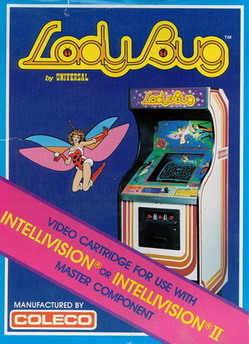
Lady Bug is a maze chase video game produced by Universal and released for arcades in 1981. Its gameplay is similar to Pac-Man, with the primary addition of gates that change the layout of the maze, adding an element of strategy to the genre. The arcade original was relatively obscure, but the game had wider recognition and success as a launch game for the ColecoVision console.

Drelbs is a maze video game written by Kelly Jones for Atari 8-bit computers and published by Synapse Software in 1983. An Apple II port by Jonathan Tifft was released the same year. A Commodore 64 version followed in 1984 implemented by Miriam Nathan and William Mandel. The objective is to move the walls of the maze to make boxes. Some reviewers found the overall collection of elements to be eccentric and unique.

Pitstop is a 1983 racing video game developed and published by Epyx for the Atari 8-bit computers, ColecoVision, Coleco Adam, and Commodore 64. A sequel, Pitstop II, was released in 1984.

Jumpman Junior is a platform game written by Randy Glover and published by Epyx in 1983 for the Atari 8-bit computers and Commodore 64. In 1984, a port was released for ColecoVision in Australia, France, Germany, Italy and the UK. It is a follow-up to Jumpman (1983). While Jumpman has 30 levels, Jumpman Junior has 12–all of which are different from the previous game. The game was reduced in scope so it could be released in cartridge form.

Threshold is a space-themed fixed shooter written by Warren Schwader and Ken Williams for the Apple II and published by On-Line Systems in 1981. Inspired by Sega's Astro Blaster arcade video game, Threshold introduces many enemy ship types and wave formations as the game progresses. Reviewers found the variety distinguished the game from the many similar shoot 'em ups.





















